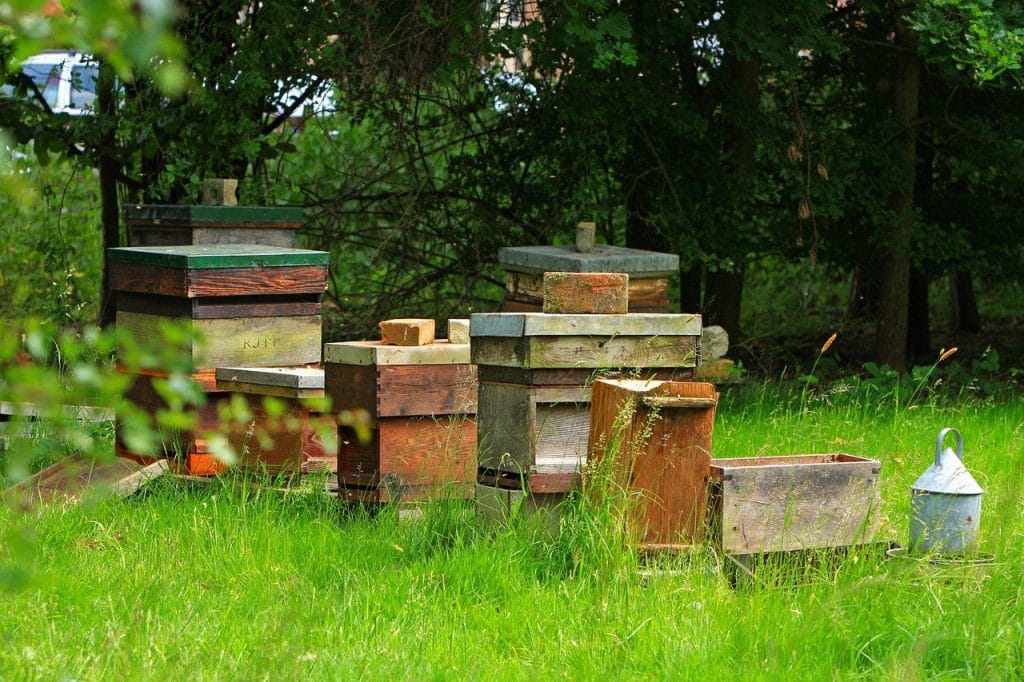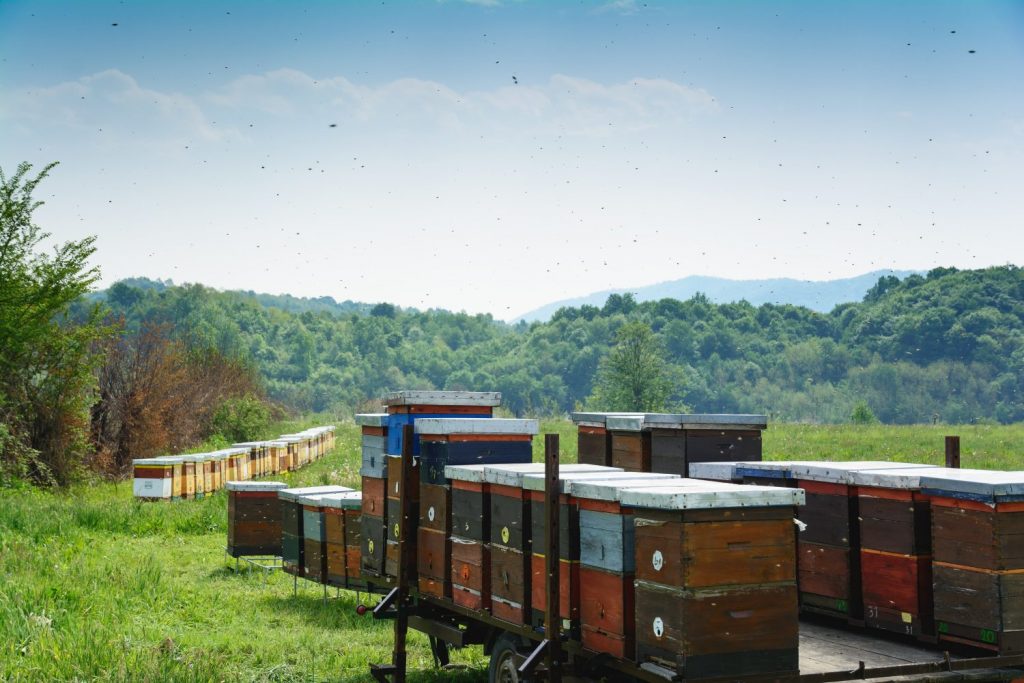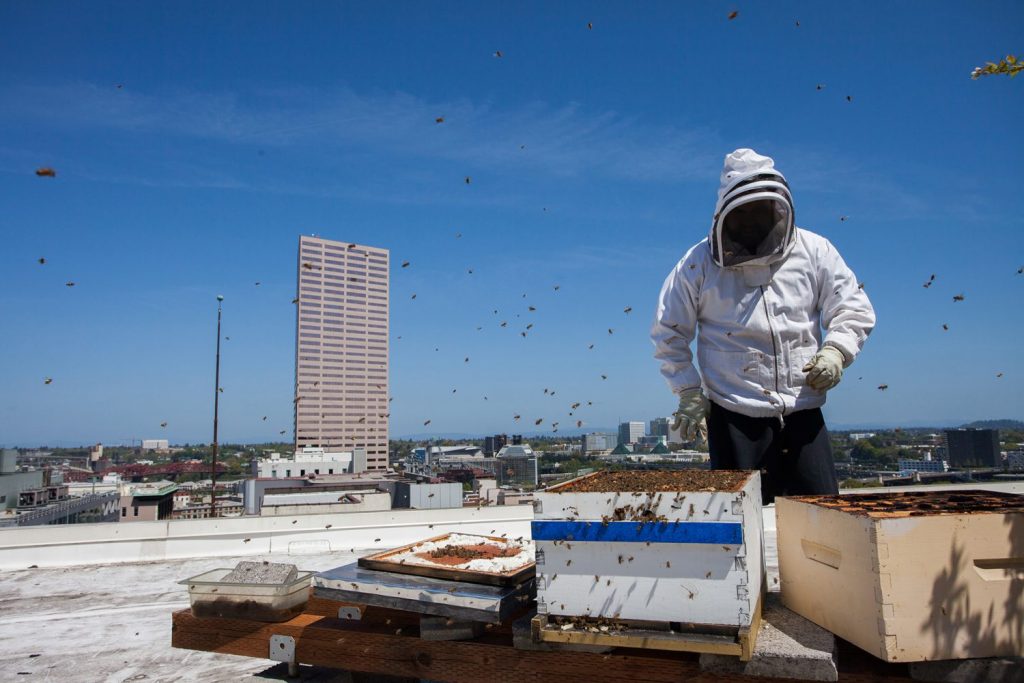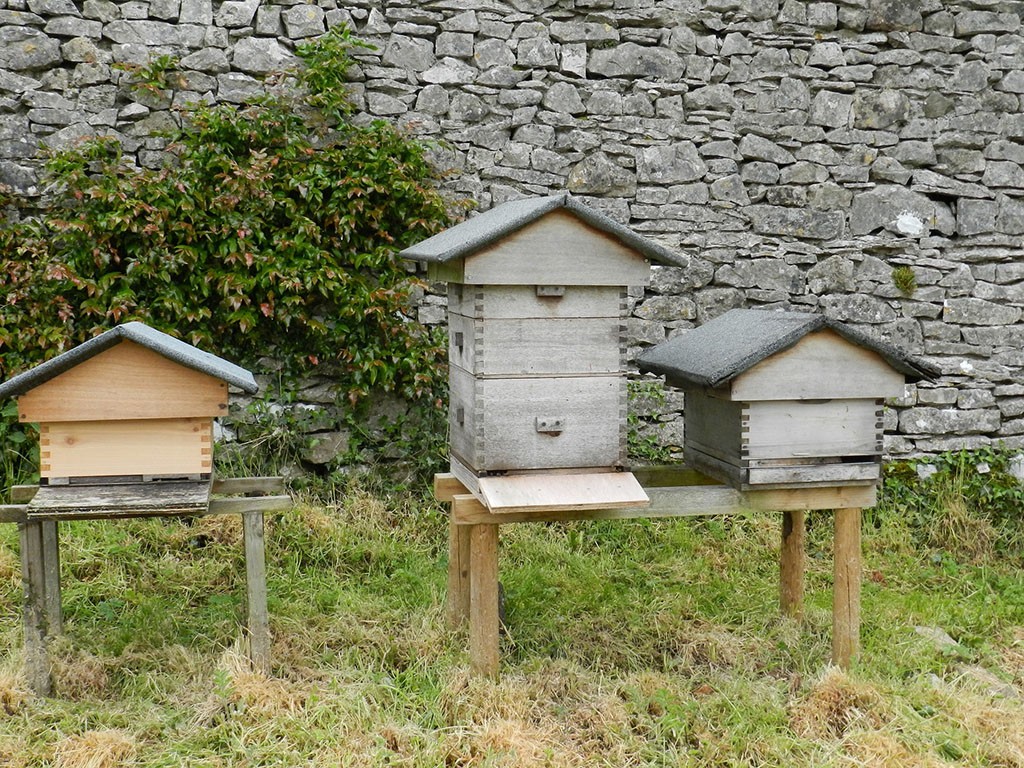If you purchase an independently reviewed item through our site, we earn an affiliate commission. Read our affiliate disclosure.
You can practice beekeeping anywhere you live. You should not be worried about where to place a beehive even if you have little space. A beehive does not need a lot of space if you meet some basic guidelines. This article lays out the requirements for placing a beehive in general terms and also for specific environments.
Beehive location determines how well the bees find their home, their ability to give maximum yields of beehive products, and safety for both humans and animals. You should be especially considerate of where to place a beehive in residential areas, so that the honeybees do not get aggravated and sting people and animals, or abscond from the beehive.
Important Requirements for Placing a Beehive
Know where to place a beehive is an easy activity when you have taken time to select the location. There are considerations you should take into account before settling on a final place to situate your beehive. You can split these requirements into three major groups: those that cater to the needs of the bees, those for the safety of the beehive, and those for the safety of the beekeeper, other people such as neighbors and animals in the area.
These main requirements apply in all environments, whether rural, suburban or urban. The important requirements for placing a beehive are:
1. Ease of Access for the Beekeeper
Put the beehive in a place to which you have easy access. Consider that you will need to bring supplies, tools and equipment to the beehive. You will also carry away harvested beehive products from the beehive after harvesting. Steep slopes are not suitable for beehive placement.
In urban settings, beehive locations should be accessible via lifts or stairs, not narrow staircases or fire escapes. Rural beehive locations require you to ensure roads and paths to the beehive are passable in all weather conditions. Additionally, place the beehive in a space to which you do not need to seek permission or notify anyone to gain access.
2. Good Drainage
Honeybees require living in dry surroundings. Too much wetness in the immediate vicinity of the beehive is reason enough for honeybees to dislike the beehive and abscond. It is even worse if the wetness in the area reaches the beehive and causes it to get damp.
Wet beehives have a lot of problems that you do not want your honeybees to contend with. They include fungal growth in the beehive and rotting of beehive wood. Additionally, the beehive may sink into wet ground and block the bottom entrance for bees. A wet environment around the beehive causes humidity to rise in the beehive, making the evaporation of water from nectar a slow and difficult process that results in low yields of honey from the beehive.
3. Water Availability
Despite the requirement to ensure the environment immediately near your beehive is dry, make sure that bees have a nearby source of water. The source of water does not need to be too close to the beehive in rural settings. In such suburban and rural settings, rivers, creeks and dams are adequate as sources of water for bees. The source of water should be at a distance from the beehive, so that the beehive is safe from any occurrence of flooding. In urban settings, place a source of water near or around your beehive.
Bees use water for various functions in the beehive. They also need to drink water for their bodily functions. Water for bees should be fresh water. It should not be stagnant water that tends to get stale and harbor harmful microorganisms.
Honeybees drown in water sources that are not planned well. Their wings get wet and they cannot get out of the water to fly away. In watering points that you provide for bees, have some stones and sticks floating in the water. Bees land on the sticks and stones, and then drink the water without wetting their wings. They are able to fly away with ease.
Providing a water source for your honeybees allows you to control the quality of water and the safety of the water source for bees. In urban settings, it prevents your bees from using water sources that will cause you problems with neighbors such as a neighbor’s kitchen sink, swimming pool or dog water bowl.
4. Ventilation
Circulation of fresh air into beehives is important for the life of bees in the beehive. Ensure natural circulation of air around the beehive. For this reason, ditches, gullies and other enclosed spaces are not very suitable for beehive placement. Have your beehive in an open space that is well ventilated.
Even with indoor beekeeping, ventilation is paramount and you must provide bees with fresh air all the time.
5. Shielding from Wind
While avoiding still air around the beehive, do not go overboard and place it in the direction of the wind. The tops of hills are not suited for beehive placement. Rooftop locations for beehives too require you to provide the beehive with shielding from wind. The major reason for this is to prevent excessive cooling of the beehive, and noise produced when winds hit the beehive.
In a windy beehive location, bees are not able to fly well and have difficulty getting back to the beehive. Common windbreaks for beehives are bales of hay, tarps and trees or plants. These do a good job at slowing down winds near and round beehives.
6. Sunlight
Allow your beehive to have sunlight shining down on it in the morning. It warms the beehive in the mornings, making your honeybees have an early start every day. In northern regions of the USA, it is great to place your beehive with its entrance facing a southerly direction. If you cannot, just make sure to allow morning sunlight to hit the beehive and warm it.
It is also important to protect the beehive from the hot midday sun. Too much heating of the beehive causes bees to use energy in cooling the hive. Some honeybees fetch water and release it in the hive, while other bees fan air into the beehive. This is energy that would be better used in producing beehive products.
Another effect of high temperatures in the beehive is destruction of honeycomb. The comb gets weak in high temperatures and may fall off beehive frames if it is heavy with brood or stored honey. You will notice high temperatures in the beehive indicated by honeybees bearding on the beehive, and honey bees standing at the entrance of the beehive and fanning air into the beehive to cool it. Dappled sunlight is therefore best for a beehive in any location you choose.
7. Level and Stable Base
Your selected place to put a beehive should be stable, and level. It should not allow the beehive to sink into the ground. Dry ground gives the best firmness for your beehive’s base. Use the equipment you have access to, to level the base on which you will place a beehive. Beekeepers often use cider blocks as their beehive supports. They elevate the beehive some distance from the ground without raising the beehive too high.
Other beekeepers use stands of various types for the same purpose. Ensure that you use a strong support to keep your beehive off the ground so that rodents, pests, parasites, insects and small animals do not have easy access to the beehive. The stand also elevates the beehive so that you have easy time working with the hive without hurting your back. It should not raise the beehive too high and make reaching the top boxes of the beehive difficult.
Bees want a level beehive to live in. ensure that the beehive is level from side to side. You may allow some forward tilt of a difference of up to 2 centimeters to help drain rainwater from the top of the beehive. A forward tilt ensures water does not enter but is drained away from the beehive and its entrance.
8. Safety for Your Household – Adults, Visitors, Pets and Children
Ensure that your beehive’s location is safe for your household. This includes adults, children, visitors and pets. Fence off the beehive so that it is not easily accessible. You may also put up a warning sign near the beehive.
9. Human and Animal Traffic Routes
Use barriers to elevate the flight path of bees coming and going from the beehive. For every foot that a bee travels horizontally, it can gain an equal foot of vertical distance. Use this rule to get the bees flying over a barrier in a flight path that takes them well above any persons or animals in the area.
You may also face the entrance of the beehive away from traffic routes. Shield the entrance from passersby so that guard bees do not perceive people passing by as threats to the beehive.
10. Spacing
Place a beehive in a space where there is ample spacing between individual beehives. This ensures you have enough space to work on beehives. You should not risk tipping over one beehive when you bend over another. Space between beehives allows for dissipation of hive odors and lowers chances of robbing happening.
11. Noise
Loud and frequent noises reaching a beehive cause honeybees to get aggravated. They then go on stinging sprees and cause you problems with neighbors and authorities. Honeybees may also abscond from the beehive due to noise in the area. Choose a place for your beehive where there is little or no noise.
12. Lights
Lights shining in the dark attract bees. Guard bees near the entrance of the beehive are attracted to the lights at night and fly to the light. They then keep flying around the light until they are burned or tired and die. Avoid this by placing the beehive in a place that is not illuminated by lights at night. It is a major problem affecting where to place a beehive in urban settings and suburban settings. Close proximity of neighbors and public spaces such as roads, often causes security lights to shine into your spaces.
If you cannot avoid it such as in urban and suburban settings, get around the problem by facing the entrance of your beehive away from the light. You may also install a shield near the light so that the beehive is in the shadow of the shield. Optionally, you can overcome this problem by talking to your neighbor and asking them to install a motion-detecting security light.
Where to Place a Beehive in a Rural Area
Large tracts of open land and plentiful of vegetation characterize rural areas. Deciding on where to place a beehive in a rural area is not easy due to the question of security. In rural areas, thieves could easily access your beehive and steal from the beehive or even the beehive itself. Additionally, there are many animals that may attack the beehive.
In a rural area, you therefore need to carefully select the location of your apiary so that you provide ample security for the beehive. This leads you to placing the beehive at the edge of your homestead, often facing the farmland that you most likely have. You are thus able to provide security for the beehive and foraging fields for the bees. In such a location, there is little risk of the bees attacking anyone or animals. Noise is also not a big problem in rural beekeeping, since rural areas are quieter than urban settings.
A simple barrier of shrubbery vegetation around the apiary location ensures safety for your household, neighbors, pets and animals in the area. It also conceals the beehive from thieves while providing shade and some forage at times.
Where to Place a Beehive on an Open Field
You may need to set up an apiary in a field in the course of your beekeeping. When deciding where to place a beehive on a field, you must factor in the temporariness or permanence of the apiary. Beekeepers that move from one place to another with their bees to provide pollination services to farmers set up temporary apiaries. When it is a permanent apiary in a field, you must provide solutions for various challenges you encounter due to the openness of the field and its distance from where you are living.
In a field location for your beehive, seek to ensure there is adequate protection from winds for the beehive. Additionally, ensure the beehive is secure or easily provided with security from thieves and animals. Other considerations such as having a firm and stable base must be taken into consideration, as well as availability of water for the bees. In a field, forage is plentiful so you need not worry about that.
The edges of a field along fences are great places to place beehives. The fence is best if it is not along a traffic route such as a road. Ensure the beehive is easily accessible.
Since you are providing pollination services in most field apiary scenarios, the beehives are spread out. This lowers your ability to secure individual beehives against thieves and animals. You have to provide these in a broad manner that encompasses all the beehives.
Where to Place a Beehive in an Urban Setting
Urban spaces are a tough nut to crack for beekeeping. There are, however, successful urban beekeepers that have figured out where to place a beehive in urban settings and run beekeeping operations. Most go for rooftops while others practice indoor beekeeping.
In urban areas, you are often spared the risk of animals attacking your beehives. Unfortunately, there is high risk of thieves attacking your beehive as well as unhappy neighbors fighting against your beekeeping practice.
Some special considerations for where to place a beehive in an urban setting are:
Early Analysis and Decision
Make an early decision on where you will place the beehive. Before you even start purchasing the beehive itself, equipment, tools and other materials for your beekeeping practice, have in mind the location where you will place the beehive. Avoid scenarios where you are ready to start beekeeping and have acquired some or all of what you need, only to find out that you do not have access to any suitable place for your beehive.
Work With the Neighbors
In urban settings, you will undoubtedly have neighbors near you. Work with them in a fair understanding. Take precautions to ensure their safety. You may inform them that you have a beehive or two in the area.
Some urban communities have community gardens with plants in them. You may approach the community garden management to host your beehive in the community garden. Most community gardens welcome bees for the pollination they provide to plants in the gardens. This is usually a fair exchange; you do not have to offer the community any of your beehive products for hosting the beehive in the community garden.
Another aspect of working with neighbors to consider when deciding where to place a beehive in an urban setting, is their acceptance of your beekeeping operation. Many people are afraid of bees and the sight of a beehive scares them. You have to decide if to let your neighbors know that you are keeping bees, or whether to keep your beekeeping operation a secret.
If the neighbors are not hostile to the idea, you can place a beehive in an area where it can be seen by some people. Even then, do not make it very obvious and easy for everyone to see you are keeping bees. In the event that you go secret with your beekeeping operation, keep the beehive out of sight of neighbors. You may even paint it the same color as your house or fence to camouflage.
Rooftop Safety
Rooftops are great locations for beehives in urban beekeeping. They, however, present a number of safety challenges to both the beekeeper and honeybee colonies. Ensure that the rooftop is easy to access so that you can manage the beehive properly and adequately. A rooftop with only difficult or dangerous access methods is not suitable for urban beekeeping.
A second challenge with rooftop beehive locations is space. Do not place the beehive too close to the edge of the rooftop. Accidents happen and you may lose your balance while at the rooftop and fall. Having reduced visibility due to wearing a beekeeping suit also increases your likelihood of falling from the rooftop. Enough distance from the edge of the rooftop to your beehive ensures you operate in a less-risky environment. If the rooftop you are using for beekeeping is under your management, consider installing high and strong barriers that prevent people from falling from the rooftop.
The third problem you encounter in rooftop apiaries is strong wind. At rooftops, winds are stronger than on ground level. Erect a suitable shield to prevent strong winds hitting the beehive. Additionally, secure all parts of the beehive with strong straps and weights to prevent them from being blown off of the beehive.
Where to Place a Beehive in a Suburban Setting
Beekeeping in a suburban setting takes the form of backyard beekeeping. When deciding where to place a beehive in a suburban setting, consider the safety requirements for all people and animals near the beehive. You also need to factor in security for the beehive. This is largely security from thieves who steal beehive products or the beehive itself.
Animals are not a major threat to beehives in suburban settings, except where such animals are found within the area. In such a suburban area, ensure that the animals do not have easy access to your beehive. This is easily achieved by fencing and elevating the beehive.
In suburban beekeeping, ensure water is available near the beehive. You should also keep the beehives out of sight by neighbors. Keep a barrier between the beehive and traffic routes to elevate the flight path of honeybees coming and going from the beehive. You may also use directional manipulation of the hive so that its entrance faces away from traffic routes.
Additionally, do your best to shield the beehive from lights that shine at night. Use motion-sensing lights to achieve this, and facing the entrance of the beehive away from such lights or a small shield near the light so that your beehive is in the shadow of the shield.
Conclusion
Following beehive location fundamentals helps you practice safe beekeeping. It also ensures you get the best results from your beekeeping practice. You enjoy beekeeping and the bees like their habitat when you place your beehive in a suitable location.
Beekeeping is easy to carry out, and rewarding in both urban and rural areas. Honeybees are able to forage on any suitable vegetation for miles around the beehive location for the resources they need in their colony.
While it is understandable that you may not be able to meet all the requirements for beehive placement due to availability of funds and the space you have, try to meet as many of the requirements as you can when deciding on where to place a beehive.
What are your thoughts on this article? Leave a comment below and let us know.
 BeeKeepClub Resources and Guides for Beekeepers
BeeKeepClub Resources and Guides for Beekeepers




You say proper spacing is needed without suggesting distances ???
Hello, about a feet apart between each beehive is fine.
thanks
[…] flowers that do not attract bees. This will help the beekeeper in making wise decisions regarding beehive location or what plants to include in their […]
[…] flowers that do not attract bees. This will help the beekeeper in making wise decisions regarding beehive location or what plants to include in their […]
[…] The main methods beekeepers use to prevent termite attacks on beehives are selecting an appropriate location and chemical and physical preventive […]
[…] The Goodland Bee Supply GL-2B2SK Double Deep Box Kit is a complete solution for setting up a Langstroth beehive, including two deep boxes, two shallow super boxes, frames, foundations, a telescoping top cover, an entrance reducer, and a queen excluder. All parts of the kit are shipped unassembled to prevent damage, but once assembled, the fully assembled beehive provides plenty of space for a honeybee colony to grow and store honey. All is needed is for you to assemble the beehive and place it at a convenient location. […]
[…] placement. These restrictions help you avoid potential conflicts. Ensure your hives are positioned away from everyday human activity and provide enough space for bees to thrive without causing discomfort to others in the […]
[…] soon as armed with the data of elevating bees you’ll be able to then discover a position to stay them. One of the choices to believe come with rooftop, yard, lawn, farmland, or a neighborhood apiary. […]
[…] soon as armed with the information of elevating bees you’ll be able to then discover a place to maintain them. Among the choices to contemplate embrace rooftop, yard, backyard, farmland, or a neighborhood […]
[…] armed with the knowledge of raising bees you can then find a place to keep them. Some of the options to consider include rooftop, backyard, garden, farmland, or a local apiary. […]
[…] armed with the knowledge of raising bees you can then find a place to keep them. Some of the options to consider include rooftop, backyard, garden, farmland, or a local apiary. […]